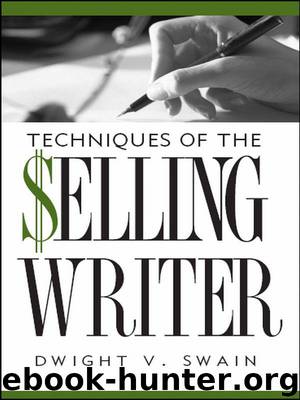Techniques of the Selling Writer by Dwight V. Swain

Author:Dwight V. Swain
Language: eng
Format: mobi
Tags: Non-Fiction, Reference, (¯`'•.¸//(*_*)\\¸.•'´¯), Writing
ISBN: 0806111917
Publisher: University of Oklahoma Press
Published: 1965-01-01T00:00:00+00:00
In fact, intelligence is an element you might very well apply to the whole cotton-pickin’ business of techniques of exposition.
f. The end of the beginning.
Desire plus danger give you a beginning for any story.
But what determines where the beginning of your story ends?
This is anything but an academic question. A beginning that drags on too long inevitably costs you readers.
Not to mention sales.
Yet that drag, that fumbling, is totally unnecessary. One simple rule eliminates it.
So, again: What determines where the beginning of your story ends?
Decision.
As early as possible, make your focal character commit himself. Let him decide to fight the danger that threatens his desire, instead of stalling or backing off or running from it.
The moment he so decides, by word or deed, your beginning is over. Your story has begun.
Why?
A story is the record of how somebody deals with danger.
Until your focal character makes up his mind to fight the danger, rather than to run from it, you have no story.
The thing that hooks your reader, in the opening, is curiosity.
The thing that holds him the rest of the way, straight through to the final paragraph, is suspense.
Curiosity is the element, on page one, that makes your reader wonder: What’s this leading up to?
So, what is it leading up to?
The fact that there’s going to be a fight.
What’s the fight about?
It concerns your character’s efforts to achieve a goal—to attain or retain something in the face of danger.
Enter the story question: Will your focal character win, or won’t he?
Enter suspense also.
Suspense is reaction. It’s a feeling your story develops in a reader. You compound it of hope plus fear—the fear that something will or won’t happen.
To have suspense, you must have uncertainty of outcome.
That’s where your story question comes in. As noted earlier, it’s always the same: Will St. George succeed in slaying the dragon—or won’t he?
Will Sam beat Ed’s time with Suzy—or won’t he?
Will Joe convince Mr. Rice he’s the man for the job—or won’t he?
Will the sergeant make it through the enemy lines—or won’t he?
Will Ellen get her husband off the bottle—or won’t she?
The key ingredient each time is doubt; uncertainty of outcome.
That doubt, that uncertainty, is what ties your reader to your story.
In other words, you open your story with curiosity-arousing devices, designed to establish (1) that your focal character has a goal, and (2) that this goal is somehow threatened.
After which, suspense takes over: Does your focal character win or lose; achieve his goal or miss it?
The issue is the moment of commitment. True suspense comes only when you establish the story question. And the story question moves into focus only when your character, desiring, looks danger full in the face and then takes up the challenge that the situation offers.
Implicitly or explicitly, he must say, “I’ll fight!” before your story can begin.
As soon as he says it, the beginning automatically ends, and we move into the story proper . . . the body of the central conflict.
This is the moment when your reader adds suspense-involvement to mere interest.
Download
This site does not store any files on its server. We only index and link to content provided by other sites. Please contact the content providers to delete copyright contents if any and email us, we'll remove relevant links or contents immediately.
Your Story Matters by Leslie Leyland Fields(1061)
Writing Children's Books For Dummies by Lisa Rojany Buccieri & Peter Economy(958)
Consider This by Chuck Palahniuk(912)
0990662659 (N) by Beth Revis(813)
The Book Club Cookbook by Judy Gelman & Vicki Levy Krupp(801)
The Spooky Art by Norman Mailer(797)
Writing Young Adult Fiction For Dummies by Deborah Halverson(797)
The Kick-Ass Writer: 1001 Ways to Write Great Fiction, Get Published, and Earn Your Audience by Wendig Chuck(718)
The Irresistible Novel by Jeff Gerke(705)
The Naive and the Sentimental Novelist by Orhan Pamuk(675)
Good Prose by Tracy Kidder(674)
The Creative Compass: Writing Your Way from Inspiration to Publication by Millman Dan & Prasada Sierra(659)
Writing from the Senses by Laura Deutsch(634)
Reading Like a Writer: A Guide for People Who Love Books and for Those Who Want to Write Them by FRANCINE PROSE(588)
The Hero Is You by Kendra Levin(568)
How to Write a Page-Turner by Jordan Rosenfeld(562)
Unless It Moves the Human Heart: The Craft and Art of Writing by Roger Rosenblatt(556)
On Writing Romance: How to Craft a Novel That Sells by Leigh Michaels(555)
Just Write by James Scott Bell(542)
